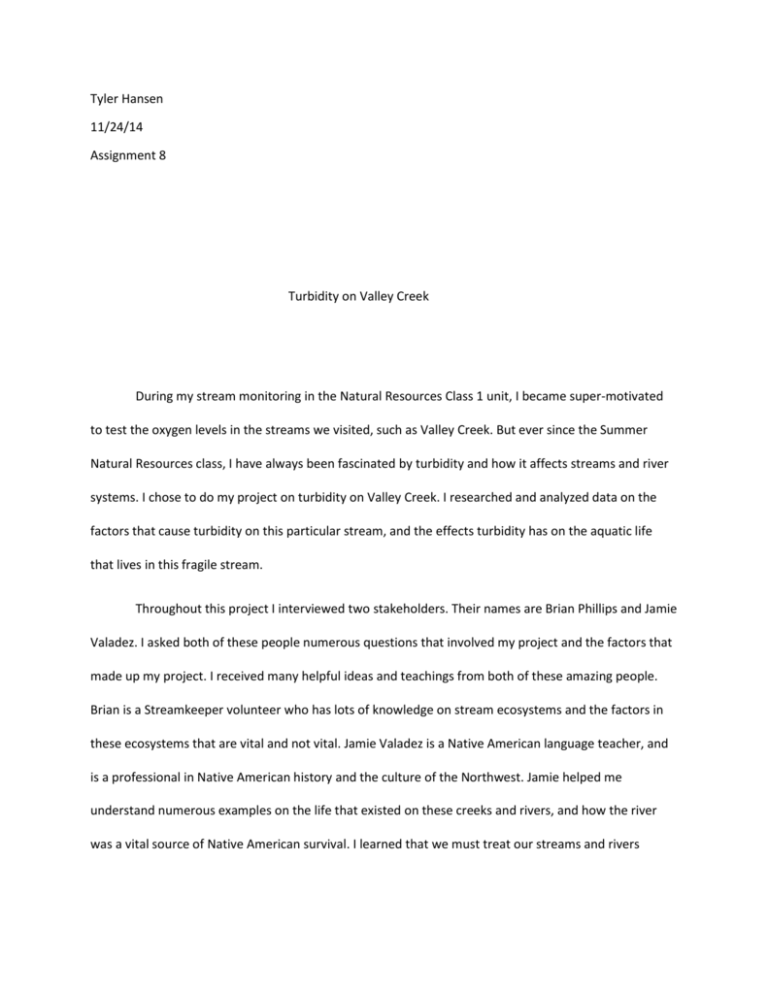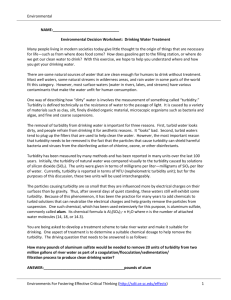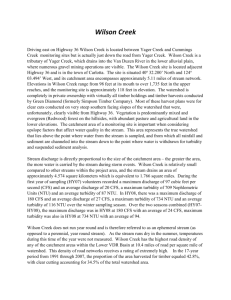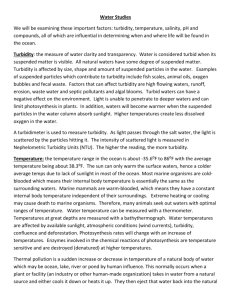Tyler Hansen 11/24/14 Assignment 8 Turbidity on Valley Creek
advertisement

Tyler Hansen 11/24/14 Assignment 8 Turbidity on Valley Creek During my stream monitoring in the Natural Resources Class 1 unit, I became super-motivated to test the oxygen levels in the streams we visited, such as Valley Creek. But ever since the Summer Natural Resources class, I have always been fascinated by turbidity and how it affects streams and river systems. I chose to do my project on turbidity on Valley Creek. I researched and analyzed data on the factors that cause turbidity on this particular stream, and the effects turbidity has on the aquatic life that lives in this fragile stream. Throughout this project I interviewed two stakeholders. Their names are Brian Phillips and Jamie Valadez. I asked both of these people numerous questions that involved my project and the factors that made up my project. I received many helpful ideas and teachings from both of these amazing people. Brian is a Streamkeeper volunteer who has lots of knowledge on stream ecosystems and the factors in these ecosystems that are vital and not vital. Jamie Valadez is a Native American language teacher, and is a professional in Native American history and the culture of the Northwest. Jamie helped me understand numerous examples on the life that existed on these creeks and rivers, and how the river was a vital source of Native American survival. I learned that we must treat our streams and rivers nicely, by not trashing them, so that in the future, and now, the rivers and streams will continue to produce life, which then gives us all life. My contribution to this project was contributing helpful information on how turbidity affects the life of streams. I helped provide an understanding on how turbidity affects this whole fragile ecosystem of streams. Turbidity is the clarity of water, and the clarity of water determines life in the river. Through my results and analysis I showed that the culverts at mouth of Valley Creek are one of the major reasons turbidity levels are high on Valley Creek. During large rains the culverts located at the mouth of Valley Creek release stormwater, which then rushes into the stream. Excessive amounts of polluted stormwater being rushed into the stream from the culverts is a terrible thing for the ecosystem of Valley Creek and the estuary in Port Angeles Harbor. The turbidity levels from 0.0 - 1.0 mile markers from the mouth on Valley Creek have turbidity levels that reach over 80+ NTU’s during these large storm events. On Valley Creek from 1.0 - 2.2 mile markers we found less turbidity because these locations are farther away from these deadly culverts at the mouth of this stream. I concluded from my data that the farther you go up stream on Valley Creek (Farther up river from the mouth of the stream) the less turbidity you will have, which results in these locations having a healthier ecosystem then the mouth locations. We observed more fish, benthic macroinvertebrates (BMI) and plant life the further we went upstream. I also concluded through our data, that the closer you get to the mouth of the stream (by these culverts) the more turbidity is observed. The local ecosystem on this creek has been compromised by development and human impacts. There are few fish, and rarely any BMIs. It’s common to see trash all over by the mouth of this creek. My views on turbidity changed a lot during the process of compiling information for my project. I used to believe all aquatic life could not live in high turbidity with little to no clarity in streams, but through talking with Mr. Lieberman, and doing research, I have discovered many macroinvertebrates can live in these ecosystems. But fish struggle under conditions of high turbidity. The collected silt, cobble, trash in these high turbidity water clog up the gills of fish, making it extremely hard for fish to survive. In the past I went to a Fly fishing Academy. I learned conservation, fish anatomy, river/stream structure/habitat, and many factors that contribute in the development of healthy streams and rivers. I also love fishing, and I love researching all the factors that involve fish and their habitats. I find it interesting that a simple factors like low oxygen levels, high turbidity and no BMIs, can affect the whole structure of an aquatic ecosystem. This project definitely made me realize what I want to do in life (although ever since I was 12, I knew what I wanted to do). I always loved fishing and everything that has to do with fishing and aquatic life. This project helped me find an interest in stream monitoring and looking deeply into the factors that make up stream environment and habitat. Through this project I learned not only how to work turbidity monitors, but I learned how to work and test for oxygen levels in streams. I love everything that has to do with water life, and I love every small particle that makes up every life form in an aquatic environment. I learned that everything in streams works for each other to further the lifecycle. I acknowledge Dave Zelenka, Dan Lieberman, and everyone that has been a part of my life, and has supported my quest to become a fisheries technician. I have realized ever since I was a young boy, you cannot further your progress in life unless you have help. And I am thankful for the opportunities and friendships I have had in my life. In conclusion, turbidity does affect the life on Valley Creek. The data showed that the closer to the mouth of the stream by the culverts the more turbidity you will have. And the data also showed that the higher you go upstream from the culverts at the mouth, the less turbidity you will have. Storm drains in these culverts release giant storm water that creates high turbidity in the 0.0-1.0 mile markers, and the 1.4-2.2 mile markers are relatively low turbidity. This is because, the farther you go upstream away from the culverts the less trash and turbidity you will find. My hypothesis was correct. Turbidity does affect the life on stream habitat. And the data proved my hypothesis. There was more fish, bugs, and life the farther away upstream you went away from the mouth of the stream. And the closer you got to the mouth of this stream and by the culverts the less fish, bugs, and life you would see. A new question I would propose in the future would be, “How does high turbidity levels affect macroinvertebrates life and function?”





